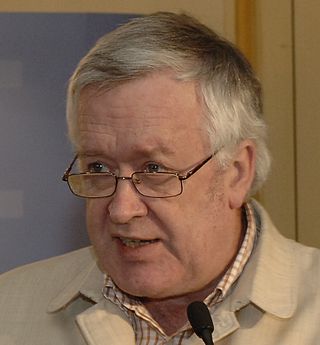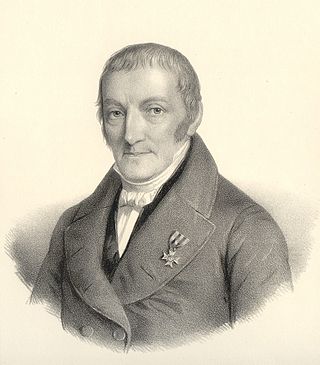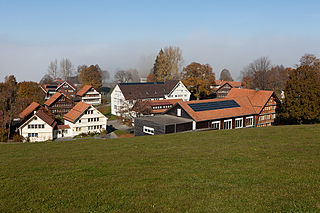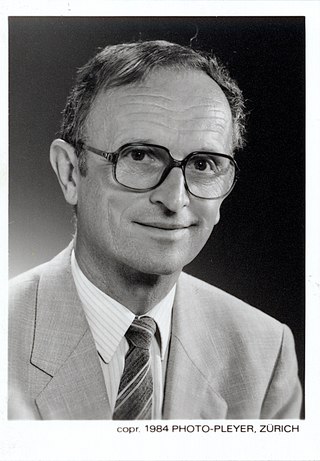
Christian Pfister (born 23 August 1944 in Bern) is a Swiss historian. [1]

Christian Pfister (born 23 August 1944 in Bern) is a Swiss historian. [1]
Pfister studied history and geography at the University of Bern from 1966 to 1970, where he graduated in 1974. This was followed by study visits to the University of Rochester and the University of East Anglia in Norwich. He habilitated in 1982. From 1990 to 1996, Pfister was supported by the Swiss National Science Foundation (SNSF) in his research on climate history. From 1997 until his retirement in 2009, he was Full Professor of Economic, Social and Environmental History at the Historical Institute of the University of Bern. For the first time, his professorship combined the three pillars of the sustainability discourse. Since 2009, he has been working as a freelance researcher at the Oeschger Centre for Climate Research at the University of Bern. His successor at the University of Bern in 2010 was Christian Rohr, who is now Professor of Environmental and Climate History. Pfister acted as founding president of the European Society for Environmental History (ESEH). [2] In addition to climate history, he has made a name for himself in agricultural history, population history, regional history, the history of natural disasters and environmental history.

Pfister is regarded as one of the pioneers in the field of historical climatology. [3] His research focuses on the social dimension of climate change and nature induced disasters, and the reconstruction of past weather and climate change from historical documents for the period before the use of instrumental measurements. He is particularly known for the further development of the Pfister climate indices, named after him, into a powerful instrument for the reconstruction of approximate values for temperatures and precipitation from historical documents. In this way, Pfister has succeeded in "connecting climate history with quantitative climate science. (...) The results obtained from Climate History, especially those concerning extreme events, contribute to improving risk assessment by broadening the basis of statistics." [4] The project "European Palaeoclimate and Man since the Last Glaciation" of the "European Science Foundation" (1989) became important for historical climate research in the longer term. In this context, Pfister led a research group that gathered documentary data from all over Europe to reconstruct monthly weather charts for the period 1675–1715. In this context, he adapted the Climhist software package, developed for the documentation of the "Climate History of Switzerland" (1984), to create the European database Euro-Climhist. Since the 1990s, Pfister has gradually expanded and methodically refined the database. Today (2019), Euro-Climhist is the largest climate history database with over 200,000 records. [5]
Agricultural-historical topics occupy a large space in Pfister's writings, since they are closely linked to climate history and population history. He distinguishes four agricultural utilisation zones in Old Swiss Confederacy: the cereal-growing area in the Swiss Plateau, the pastoral area in mountainous areas, a zone of mixed field-grass cultivation in hilly areas, and areas of intensive viticulture. The main focus of his analysis and models is on cereal production. In this context Pfister has worked out the importance of the nitrogen cycle for productivity development. [6] 3
Since Erich Keyser’s Population History of Germany (Leipzig, 1938) no synthesis had been written for German speaking areas in the Early Modern Period. At the beginning of the 1990s, Christian Pfister took on the task of collecting and compiling a hardly comprehensible number of small-scale, at best regional and heterogeneous studies worked out over half a century, and to press them into the framework of a small volume of the Encyclopaedia of German History.
Both Christian Pfister’s dissertation (1974) and his habilitation thesis (1984) were committed to the histoire totale of the Annales School in addition to climate history. His focus on the Canton of Bern opened up a field of regional history that continued to occupy him in the years that followed. Through the fine division of its landscape, the Canton of Bern offers a patchwork of zones which followed different paths in their development. Pfister’s monograph "Im Strom der Modernisierung" (Bern, 1995) meets the methodological postulate of a histoire totale with extraordinary precision and spatial-temporal differentiation; and can be regarded as a material history in the best sense of the word, in which energy sources and food, agricultural production methods and their modernization appear just as much as the people who give birth, eat, work, argue, invent, try, age and die, and are not only processed into statistical series of numbers. [7]
Concurrent to Climhist, Christian Pfister set up the BERNHIST regional history database from 1984. In 2009, the database contained around 1.5 million individual data from the fields of population, economy, environment and politics for the period from 1700 to the present. In 2019, a modernized version of BERNHIST was launched. [8]
Based on its energy base (biomass, coal, oil, and gas), Pfister divides economic and environmental history into three fundamental social periods – agricultural society, industrial society and consumer society. His thesis is that the current urgency of the climate problem and the glut of plastic waste is due to the flooding of markets with cheap oil from the late 1950s onwards. The corresponding anthology (Pfister 1995b) experienced a second edition in 1996. An enlarged synthesis in English was published in 2010. [9]
From 1882 to 1976, Switzerland was largely spared natural disasters. Pfister demonstrates that this "disaster gap" (German : Katastrophenlücke) contributed to natural risks being underestimated until the late 1980s. It was not until this time that natural disasters were discovered as an attractive topic in historical research. In his "Weather Hindcast" (1999), Pfister links the climate variations of the last five hundred years in Switzerland with the description of severe natural disasters. He postulates that natural disasters can be regarded as pacemakers of modernization and, at least in Switzerland, were fundamental for the development of a nationwide solidarity between the poor mountain regions and the wealthy regions in the Swiss Plateau. With these theses he succeeded in giving a new depth to the primarily cultural-historical discussion about the interpretation and perception of disasters. He has written several articles on natural disasters and, together with Christof Mauch, published an anthology on this topic in 2009. [10]
Christian Pfister was awarded the following distinctions:
Complete publication list online

Bern, or Berne, is the de facto capital of Switzerland, referred to as the "federal city". With a population of about 133,000, Bern is the fifth-most populous city in Switzerland, behind Zürich, Geneva, Basel and Lausanne. The Bern agglomeration, which includes 36 municipalities, had a population of 406,900 in 2014. The metropolitan area had a population of 660,000 in 2000.

The Christian Democratic People's Party of Switzerland, also called the Christian Democratic Party, Democratic People's Party and Swiss Christian Democratic Party, was a Christian-democratic political party in Switzerland. On 1 January 2021, it merged with the Conservative Democratic Party of Switzerland (BDP/PBD) to form The Centre, which now operates at the federal level. The Christian Democratic People's Party will continue to exist at the cantonal level as individual local and regional parties determine their status.

The University of Bern is a public research university in the Swiss capital of Bern. It was founded in 1834. It is regulated and financed by the Canton of Bern. It is a comprehensive university offering a broad choice of courses and programs in eight faculties and some 150 institutes. With around 19,000 students, the University of Bern is the third largest university in Switzerland.

Hans von Storch is a German climate scientist. He is a professor at the Meteorological Institute of the University of Hamburg, and Director of the Institute for Coastal Research at the Helmholtz Research Centre in Geesthacht, Germany. He is a member of the advisory boards of the journals Journal of Climate and Annals of Geophysics. He worked at the Max Planck Institute for Meteorology from 1986 to 1995 and headed the Statistical Analysis and Modelling research group there.

Karl Ludwig von Haller was a Swiss jurist, statesman and political philosopher. He was the author of Restauration der Staatswissenschaft, a book which gave its namesake to the Restoration period after the Congress of Vienna, and which Georg Wilhelm Friedrich Hegel strongly criticized in §258 of Elements of the Philosophy of Right.

The Oberhasli is a historical Landvogtei or Talschaft in the Bernese Highlands, Switzerland, bordering on the cantons of Obwalden (OW), Nidwalden (NW), Uri (UR) and Wallis (VS).

Münchenbuchsee is a municipality in the Bern-Mittelland administrative district in the canton of Bern in Switzerland. It is famous as the birthplace of the painter Paul Klee.

Religion in Switzerland is predominantly Christianity. According to the national survey of the Swiss Federal Statistical Office, in 2020, Christians accounted for 61.2% of the resident population, of whom 33.8% were Catholics, 21.8% were Swiss Protestants, and 5.6% were followers of other Christian denominations. The proportion of Christians has declined significantly since 1980, when they constituted about 94% of the population; during the same timespan, unaffiliated Swiss residents have grown from about 4% to 31% of the population, and people professing non-Christian religions have grown from about 1% to 7% of the population. In 2020, according to church registers, 35.2% of the resident population were registered members of the country's Catholic Church, while 23.3% were registered members of the Protestant Church of Switzerland.
Lukas Vischer was a Swiss Reformed Theologian. From 1961 he was Research Secretary of the World Council of Churches’ (WCC) Faith and Order Commission in Geneva and from 1966 until 1979 the Commission’s Director. From 1980 until 1992 he headed the Protestant Office for Ecumenism in Switzerland and taught Ecumenical Theology at the Theological Faculty of the University of Bern. From 1982 until 1989 he was moderator of the World Alliance of Reformed Churches’ (WARC) Theology department and from 1982 until 2008 moderator of the John Knox International Reformed Centre’s Programme Commission in Geneva. In these years, ecological responsibility of the Churches became a focal point of his work.
Christof Mauch is a German historian, presently director of the Rachel Carson Center for Environment and Society in Munich, Germany, and since 2007 professor of American Cultural History and Transatlantic Relations at Ludwig Maximilian University of Munich. From 1999 to 2007 Christof Mauch was the director of the German Historical Institute in Washington D.C.. Mauch received his Dr. phil. in Modern German Literature from the University of Tübingen in 1990, and his Dr. phil. in Modern History in 1998 from the University of Cologne. He has published and edited many books in the fields of U.S. and German History and Environmental History. From 2009 to 2011 Christof Mauch was chair of the Board of Directors of the International Consortium of Environmental History Organizations (ICEHO) and from 2011 to 2013 President of the European Society for Environmental History. In May 2013 he was appointed Honorary Professor at Renmin University, Beijing, China.In the same year he was awarded the Carl-von-Carlowitz Prize of Germany's Council for Sustainable Development, and in 2017 he received the Award for a Distinguished Career in Public Environmental History from the American Society for Environmental History.
The Rachel Carson Center for Environment and Society (RCC) is an international, interdisciplinary center for research and education in the environmental humanities located in Munich, Germany. It was founded in 2009 as a joint initiative of LMU Munich and the Deutsches Museum, and is supported by the German Federal Ministry of Education and Research. The center is named after the American biologist, nature writer, and environmentalist, Rachel Carson.

The Lorraine railway viaduct, or Lorraineviadukt, is a railway viaduct in the Swiss city of Bern. It carries the Olten–Bern railway across the River Aare immediately to the north of Bern railway station. The Lorraine road bridge is adjacent.
Thomas Dominik Meier is a Swiss historian. He has served as president of Zurich University of the Arts (ZHdK) since 2009.

Kinderdorf Pestalozzi is a non-profit organization located in Trogen, Canton Appenzell. It was named after the Swiss education pioneer Johann Heinrich Pestalozzi. Established in 1945, the Stiftung Kinderdorf Pestalozzi provides the Kinderdorf village for war-affected children from all over the world.
Adam Maurizio was a Swiss botanist, specialist of food technology and cultural history, born 26 September 1862 in Kraków and died 4 March 1941 in Liebefeld near Bern. He gained international recognition for his works on the history of plant food.

Elias Landolt (1926–2013) was a Swiss geobotanist, known for his publications on Switzerland's native flora and Lemnoideae.
Rudolf Braun was a Swiss historian.
The 1540 drought in Europe was a climatic event in Europe. In various palaeoclimatic analyses the temperature and precipitation regimes were reconstructed and compared to present-day conditions.

Heinz Wanner is a Swiss geographer and climate researcher. He is a professor emeritus and works at the Oeschger Centre for Climate Change Research of the University of Bern.

The Appenzeller Barthuhn is a Swiss breed of bearded chicken originating in the historical Appenzell region of Switzerland. It is one of two chicken breeds from that area, the other being the Appenzeller Spitzhauben; the only other Swiss breed of chicken is the Schweizer.